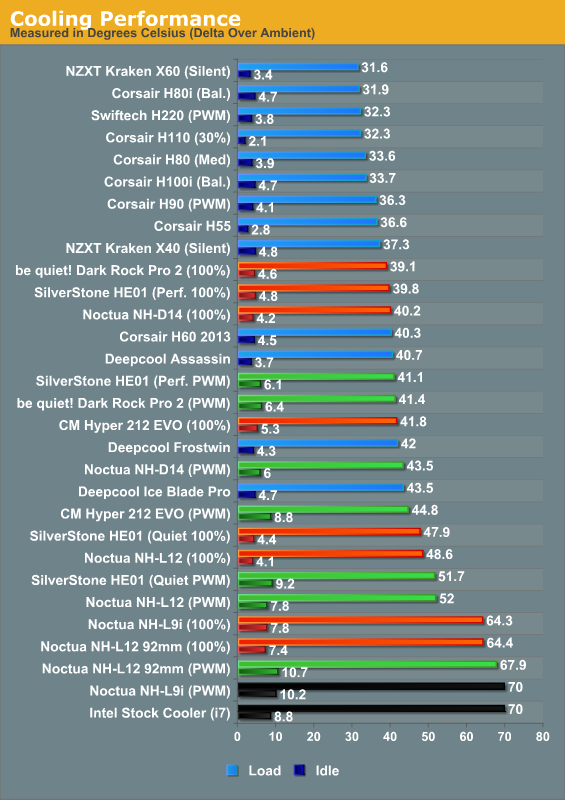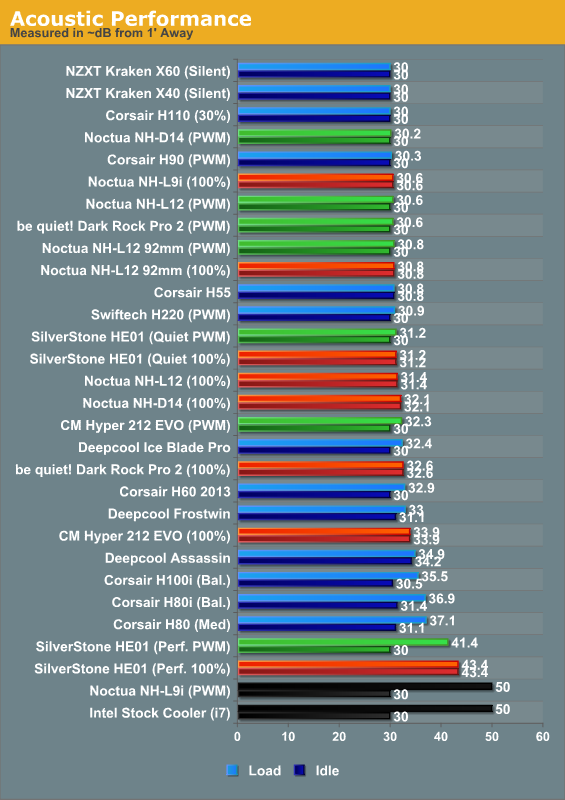CPU Air Cooler Roundup: Six Coolers from Noctua, SilverStone, be quiet!, and Cooler Master
by Dustin Sklavos on March 14, 2013 2:40 AM EST- Posted in
- Cases/Cooling/PSUs
- Cooler Master
- SilverStone
- cooling
- Noctua
- be
Performance Results
Given that I've been doing these cooler reviews entirely in roundups, it's probably no surprise that the amount of results I've put together have absolutely ballooned. So much so that including all of the results in every graph would result in some very, very long graphs. With that in mind, for the master list of coolers (including all of the results from the current roundup), I'm only including what I feel are the most balanced results for a given cooler. I'm taking into account if ratcheting up fan speed doesn't produce much of a difference in performance, or if ratcheting it down makes a huge difference.
Results in black are for coolers that actually failed testing.

Out of this roundup of coolers, the three big boys put in the best performance overall, tying or beating Deepcool's flagship Assassin. Unfortunately, they have to run at full bore to really start to nip at the heels of the closed loop coolers. None of them are bad coolers, but the metrics I'm using here really don't tell the whole story.

The nice thing about these new coolers is that none of them are really that loud, with the exception of SilverStone's HE01. The fan Cooler Master employs on the Hyper 212 EVO isn't particularly quiet, but at full bore it's still fairly easy to ignore.
In the midst of all these results, it's unfortunate that Noctua's NH-L9i pretty much has to run at full bore to be usable. It's a definite improvement on the Intel stock cooler, but you're still not really going to be doing any overclocking with it. Its chief advantages over the stock cooler are going to be its lower noise level under load and superior mounting mechanism.










63 Comments
View All Comments
cjs150 - Thursday, March 14, 2013 - link
Personally I would also prefer water cooling for the simple reason that a good (thick) 240/280 Radiator can cool both CPU and GPU and there is no need to worry about whether the RAM heatspreaders are too tall for the air cooler.What the result show is just how good the closed loop water coolers have become.
However, there is no denying air cooling is simpler, less prone to messy accidents (I know!) and perfect for those who like to keep the computer on all the time. Nice review and keep up the good work
James086 - Friday, March 15, 2013 - link
A minor caveat: be sure to point a fan at the ram and motherboard heatsinks. I didn't and because there was no airflow around my motherboard, it popped a VRM.StevoLincolnite - Monday, March 18, 2013 - link
Ram cooling isn't important, they don't even need heatsinks, it's all for looks.However, motherboard cooling is important, spend a little extra and get a motherboard with decent heatsinks or even active cooling like the Sabertooth x79.
Plus, case airflow is important too.
maximumGPU - Thursday, March 14, 2013 - link
Nice review! wish there was a thermalright silver arrow on there to get a more comprehensive look at the high end coolers. When i bought mine it was widely considered superior to closed loops, looking at the review's results i'm not so sure about that now.wiyosaya - Tuesday, April 2, 2013 - link
I've been a fan, pun intended, of Thermalright paired with Scythe fans for a long time. I currently have a TRUE Spirit 120M paired with a very low noise 120mm Scythe fan cooling an i7-3820. The absence of noise was a prime factor for me, and I don't overclock because stability is also of prime concern for me. IMHO, this combination works very well.I, too, would have loved to have seen any of the Thermalright heat sinks in this review.
iTzSnypah - Thursday, March 14, 2013 - link
I don't believe that the case has adequate airflow.iTzSnypah - Thursday, March 14, 2013 - link
Also there is a fault in your testing methodology. When you tested the CLC's you effectively increased the number of case fans, which would increase airflow and decrease load temps.I suggest you retest, with the case always having 3 fans, 1 intake and 2 exhaust.
FragKrag - Thursday, March 14, 2013 - link
I don't think the point here is to get a completely unbiased performance test, but rather test the coolers in a realistic environmentdragosmp - Thursday, March 14, 2013 - link
The thing is there's not more realistic not to have case fans than to have them. One may argue that it's more likely to encounter systems that have one/two exhaust fans than to have only one intake.I'm suspicious of these results as most sites put aircoolers in a much better light and my own experience show it's a bad bad thing to remove rear fans.
In this setup aircloolers spit warm air that is hardly being channeled out by anything; the positive pressure generated by the front intake can be dissipated in many ways that don't move the warm air around the CPU zone. I've worked recently with a 600T, if the up/rear fans were slowed to 400RPM (so still working) with a CM 212+ @1200RPM and a 2700K@4.2GHz the CPU got toasted in games 80°C+ - running the fans @800RPM decreased the temp by some 20°C.
"I removed every case fan but the front intake, which I ran at 5V to prevent it from affecting acoustics while still providing adequate airflow." - how much airflow was there thru the fan-less rear exhausts?
lever_age - Thursday, March 14, 2013 - link
Right, look at how restrictive the back panel looks. Some people with intake-heavy setups (and that would be a whole lot more than a single fan at 5V in a large case that's very far away from the CPU cooler) cut out the spot and use a wire grille instead, and remove slot covers.If it weren't for some of the top venting, the air coolers would have been really suffocated. In that setup, there is a bias towards the CLCs because their fans are actually working close to the actual vents on the case, due to how everything is mounted and positioned.
If you're only testing down to 30 dB, you can easily run a few more decent-quality fans at some ~800 rpm and get some more reasonable airflow without really increasing the noise level measured.